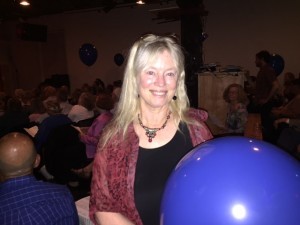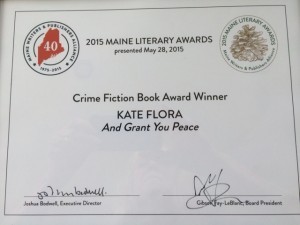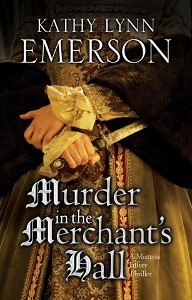Lea Wait's Blog, page 290
May 31, 2015
Meet New Maine Crime Writer Mary Lawrence
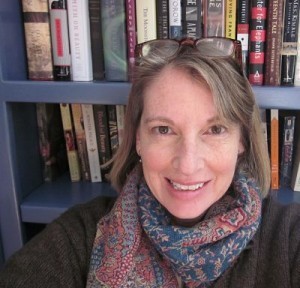 Q: Your debut novel is a historical mystery set in Tudor London. Why did you want to tell your story in that place and time?
Q: Your debut novel is a historical mystery set in Tudor London. Why did you want to tell your story in that place and time?
A: I was drawn to the dark humor of 16th century writers like Ben Jonson, Thomas Dekker, and pamphleteers. It was difficult living under Henry VIII with his erratic political and religious policies. The writers from that time reacted with droll skepticism and piety (or what they believed was pious). A more sophisticated world view was dawning but they were still heavily influenced by old beliefs and superstition. Their sometimes strange logic and polarized thinking intrigued me.
Q: In a sentence, what is your book about?
A: The daughter of an infamous alchemist must prove her innocence in the murder of a friend and uncover its connection to a mysterious ship and influx in the number of rats before she is convicted and London succumbs to the plague.
Q: Why write a mystery?
A: I love period mysteries, especially those set in Tudor and Elizabethan England. However, I became more interested in learning about the citizens of Tudor London rather than read court-centered intrigues. I’d never written a mystery before, so I took it on as a personal challenge. For years I’d been reworking a story about the daughter of an alchemist. I decided to keep some of the characters and raise the stakes for my heroine. The result was a completely different story for her.
I wrote The Alchemist’s Daughter as a standalone and when Kensington was interested in doing a series I had to scramble to come up with plots for two more books. Death of an Alchemist will be released in February of 2016 and has more alchemy in it.
Q: What differentiates your heroine from others?
A: Bianca Goddard is an amateur sleuth combining her love of science with the desire to understand 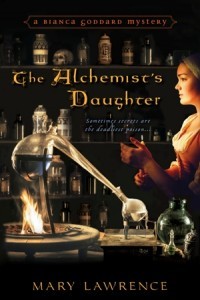 what motivates humans to murder. To my knowledge, there are no alchemist sleuths in literature. While Bianca riles at being called an alchemist, she does understand its usefulness. As the series goes on, she will slowly become more inclined to dabble in alchemy, but this has to come with great inner conflict.
what motivates humans to murder. To my knowledge, there are no alchemist sleuths in literature. While Bianca riles at being called an alchemist, she does understand its usefulness. As the series goes on, she will slowly become more inclined to dabble in alchemy, but this has to come with great inner conflict.
Q: Who do you think would like your book?
A: I think mystery lovers, historical novel readers, and those interested in Tudor/Elizabethan period novels will connect with the book. It might appeal to a higher young adult audience, too. There is a slight element of the mythic, too. As one reviewer put it, if you like historical mysteries with a little romance and creep factor thrown in, you’ll like The Alchemist’s Daughter. It’s kind of a strange book in that it’s difficult to categorize exactly.
Q: What is your interest in alchemy?
A: Alchemy was as much a philosophical belief system as it was a rudimentary science. It evolved over several centuries and across three continents and encompassed not only science, but religious, mathematical, and mystical ideas. Alchemists believed one must have the right destiny to succeed and failure was a fault of personal character.
Alchemists strove for perfection in their approach to chemistry and in their devotion to it. One may not be born with the right destiny but if one were disciplined, they could create their fate. The improbability of success was assured, and in my mind, this certainty makes for a provocative group of explorers forced to confront constant failure, poverty and denial.
I come from a medical background and studied chemistry and biology in college. I love history, too, so all of these subjects appeal to me and I get to keep learning about it all.
Q: What do you hope readers will get out of the book?
A: Basically I hope to entertain. My writing style is a bit campy, and I want to take the reader on a ride through 1543 Tudor London. The Alchemist’s Daughter is commercial fiction, not meant to be taken too seriously—I want the reader to have fun.
Q: Tell us some things that are special about Maine for you.
A: Riding the ferry to Peaks Island under the Fourth of July fireworks on Casco Bay. Sunday afternoons eating coconut ice cream at Big Daddies in Hollis after working all day in the fields. Double rainbows stretching over Boyd Pond in Limington after a summer storm. Watching a solar eclipse from my deck overlooking Great Pond in Cape Elizabeth. The stars any night anywhere in Maine.
Q: You have a whole other identity as a farmer – what do you grow, and does your knowledge of agriculture influence your writing?
A: We grow a variety of fruit–blueberries, raspberries, sour cherries, elderberries and lingonberries.  Farming keeps me grounded and reminds me what really matters. I’m proud that we took 7 acres of quarried land in Limington and have turned it into a productive farm. We’re still learning and it’s a challenge to figure out what pest or disease is seeking to ruin our hard work. I love being around farmers and folks who garden. If the world falls apart tomorrow at least I can eat blueberries.
Farming keeps me grounded and reminds me what really matters. I’m proud that we took 7 acres of quarried land in Limington and have turned it into a productive farm. We’re still learning and it’s a challenge to figure out what pest or disease is seeking to ruin our hard work. I love being around farmers and folks who garden. If the world falls apart tomorrow at least I can eat blueberries.
Mary Lawrence studied biology and chemistry, graduating from Indiana University with a degree in Cytotechnology. After working for years as a cytologist, she now farms and writes in Limington. The Alchemist’s Daughter is the first book in the Bianca Goddard Mysteries. You can visit her at www.marylawrencebooks.com
May 29, 2015
Weekend Update: May 30-31, 2015
Next week at Maine Crime Writers there will be posts by special guest Mary Lawrence (Monday), Kate Flora (Tuesday), Brenda Buchanan (Wednesday), Al Lamanda (Thursday) and Susan Vaughan (Friday).
In the news department, here’s what’s happening with some of us who blog regularly at Maine Crime Writers:
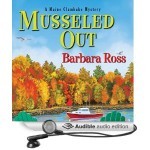 from Barb Ross: For all you audiophiles (audiobookphiles?), I’m pleased to announce that Musseled Out, the third Maine Clambake Mystery, will be released as an audiobook by Audible this Tuesday, June 2nd. You can find it here.
from Barb Ross: For all you audiophiles (audiobookphiles?), I’m pleased to announce that Musseled Out, the third Maine Clambake Mystery, will be released as an audiobook by Audible this Tuesday, June 2nd. You can find it here.
If you are reading this on Saturday, why not hop on over the Hartland Library today from 1-3 to celebrate John Clark‘s retirement and meet the new Hartland Librarian?
from Kate Flora: Excited, honored, and very grateful to have received the 2015 Maine Literary Award for Crime Fiction for my fourth Joe Burgess police procedural, And Grant You Peace. Thanks, Brenda Buchanan, for the photograph. And yes, winners get big blue balloons.
Finally, if you are a crime writer, aspiring crime writer, or fan of crime writing, Saturday is the day registration opens for The New England Crime Bake, our annual mystery conference featuring New England authors. The Bake is held in Dedham, Massachusetts the weekend of November 6, 7 & 8, and this year’s guest of honor is Elizabeth George. Register here: http://crimebake.org
An invitation to readers of this blog: Do you have news relating to Maine, Crime, or Writing? We’d love to hear from you. Just comment below to share.
And a reminder: If your library, school, or organization is looking for a speaker, we are often available to talk about the writing process, research, where we get our ideas, and other mysteries of the business. Contact Kate Flora: mailto: kateflora@gmail.com
May 28, 2015
Guest Edith Maxwell on Farming in Maine
by Barb Ross, who’s joyously celebrating her daughter’s graduation today from UMass Boston with an MFA in Creative Writing
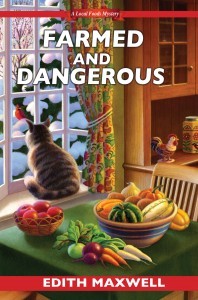 Normally, you’ll find Edith Maxwell hanging out with me at the Wicked Cozy Authors Blog. We see ourselves as the (sometimes less gritty sisters) of the Maine Crime Writers. We’re all mystery, we’re all New England. It’s all good.
Normally, you’ll find Edith Maxwell hanging out with me at the Wicked Cozy Authors Blog. We see ourselves as the (sometimes less gritty sisters) of the Maine Crime Writers. We’re all mystery, we’re all New England. It’s all good.
Today, we’re celebrating the release of Edith’s third entry in her Local Foods Mysteries for Kensington, Farmed and Dangerous. Her protagonist, Cam Flaherty, operates a farm in northern Massachusetts, and Edith has done some of her research in Maine.
Don’t you love the cover? I think it’s gorgeous.
Farming in Maine
Thanks for having me back to the blog, Barb! My Local Foods Mysteries are set in the northeast corner of Massachusetts, where the winters are dark and cold. The shortest days, in December, are nine hours long. Even when it’s up, the sun hangs low and weak in the sky. February tends to be the coldest month, even though the days are an hour and a half longer. But of course, ye in Maine know better than I how dark and cold it is during the winter.

photo credit: Toddy Farm Pond
tall milfs cougars that crave black cocksSo what’s a farmer to do? Traditionally, all the fields were put to bed and all the crops harvested by December at the latest. Farmers used to spend the cold dark months oiling and sharpening tools, eating up stored and preserved vegetables, tending animals if they had them, and dreaming of starting seeds again.
But now many New England farmers bank on growing greens and other crops all winter long in high tunnels – structures without a foundation that consist of hoops or arches made of pipes, with doors, wooden end walls, and a covering of one or two layers of heavy plastic. This is what my farmer, Cam Flaherty, tries to do in Farmed and Dangerous, which is set in January – when she isn’t off solving a murder, that is.
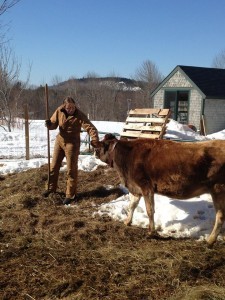
photo credit: Toddy Pond Farm
I spent a few days last year at Toddy Pond Farm, a fabulous Maine family farm. It’s tucked into the woods in Monroe, near Belfast. I’ve known the farmers, Greg and Heide Purinton-Brown, a long time. I first met Greg, as well as his parents and older brother older brother, when he was a young teenager. I attended Greg and Heide’s lovely outdoor wedding in New Hampshire, and applauded from afar the birth of their two sons, Guthrie and Oliver. Imagine my delight to learn a couple of years ago that Greg and Heide are now farmers, homeschooling their sons (now almost the ages Greg and Justin were when I met them), working the land, and tending a passel of animals.
My own farmer son and I trekked up to Monroe one weekend in the fall. Toddy Pond includes a wonderful guest house that they rent out to visiting families, artists, and groups on retreat (consider it, writers!), and JD and I were invited to stay there. It’s an airy, comfortable retreat house that sleeps seven. And you can walk to a lake and jump in for a dip when it’s hot.
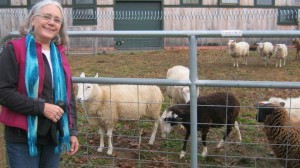
Edith and friends
The whole place is idyllic. They raise cows, dairy sheep, pigs, truly free-range chickens, and bees. They grow all their own vegetables and host Farm-to-Table dinners. They’ve restored a couple of cranberry bogs. They bottle and create the most delicious milk, full-fat yogurt, kefir, cheese, and ice cream you could ever dream of. The farm has a solar powered barn and an attack rooster named Ruffles, both of which I copied shamelessly into Farmed and Dangerous. They call all the animals by name, even the ones who are destined to end up as bacon or chicken stew; they also sell meat, and no animal was ever raised more humanely. And the four Purinton-Browns seem so happy! They work really hard, don’t get me wrong. But it’s obviously a healthy, satisfying life.
You Mainers are lucky. You can find the Toddy Pond products at stores and farmers’ markets up and down the coast. I know I sound like a salesperson – but I’m not on the payroll, believe me! Maybe Cam needs to go up for a visit one of these books.
Readers, what’s your favorite Maine farm? Are you a farmers’ market devotee?
Bio:
Agatha-nominated and Amazon-bestselling author Edith Maxwell writes four murder mystery series, most with recipes, as well as award-winning short stories.
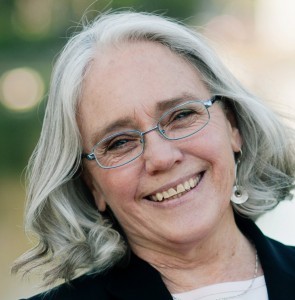 Farmed and Dangerous is the latest in Maxwell’s Local Foods Mysteries series (Kensington Publishing). The latest book in the Lauren Rousseau mysteries, under the pseudonym Tace Baker (Barking Rain Press), is Bluffing is Murder. Maxwell’s Country Store Mysteries, written as Maddie Day (also from Kensington), will debut with Flipped for Murder in November, 2015. Her Quaker Midwife Mysteries series features Quaker midwife Rose Carroll solving mysteries in 1888 Amesbury with John Greenleaf Whittier’s help, and will debut in March, 2016 with Delivering the Truth.
Farmed and Dangerous is the latest in Maxwell’s Local Foods Mysteries series (Kensington Publishing). The latest book in the Lauren Rousseau mysteries, under the pseudonym Tace Baker (Barking Rain Press), is Bluffing is Murder. Maxwell’s Country Store Mysteries, written as Maddie Day (also from Kensington), will debut with Flipped for Murder in November, 2015. Her Quaker Midwife Mysteries series features Quaker midwife Rose Carroll solving mysteries in 1888 Amesbury with John Greenleaf Whittier’s help, and will debut in March, 2016 with Delivering the Truth.
A fourth-generation Californian, Maxwell lives in an antique house north of Boston with her beau and three cats. She blogs every weekday with the other Wicked Cozy Authors (http://wickedcozyauthors.com), and you can find her at www.edithmaxwell.com, @edithmaxwell, on Pinterest and Instagram, and at www.facebook.com/EdithMaxwellAuthor.
May 27, 2015
When Days Are Dark
In April I attended three writers/fans conferences, one for people who write or illustrate books for children, and two for mystery readers and writers. I also spoke at one library, visited one school in person, and visited another school via Skype. Since then I’ve
made another half dozen appearances.
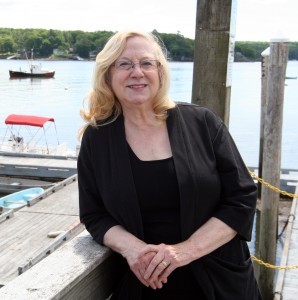
Lea Wait
And, over and over, people (often “pre-published” writers) told me how lucky I was. After all: I’ve had thirteen books published since my first was published in 2001, and I have contracts for more.
And, yes. I am lucky. I also do what most published writers do. I work hard. I do a lot of research. I write and re-write and re-write again. And, when a book is published, I visit bookstores and libraries and schools (and conferences). I blog. (Here I am!) I don’t do as much social media as some of my fellow authors, but I’m on Goodreads and Facebook. (Friend me, both places!) And if I’m not working on a book, and sometimes even when I am, I’m planning another one. Or two. I love my life … but I work seven days a week at my writing job, all year.
Still: I am lucky. Although my first mystery was rejected by more than forty agents, eventually it (Shadows at the Fair) was picked up by Scribner/Pocket Books and was an Agatha finalist. I met my first editor at a critique session at a conference for children’s writers in the spring of 1999, and he bought my first book to be published (Stopping to Home.)
Then why have I titled this blog “When Days Are Dark”?
Because my first four historical novels for children and my first four mysteries sold. To a large publisher, Simon and Schuster. Got great reviews. Were nominated for an Agatha. Sold respectably.
And then … my mystery editor retired, and my Shadows series was discontinued. Six months after that, my children’s editor was laid off and replaced by someone who wasn’t interested in historicals.
Within six months I went from having two editors to having none.
What did I do? After I cried and ranted and felt depressed and sorry for myself. I got back to writing. I wrote an adult historical mystery. It took a lot of research and time. And it didn’t sell. “It’s not a cozy” and “it’s not violent enough,” were the two comments I got from editors. I wrote historicals for children: one set during the American Revolution, a time period teachers and librarians had repeatedly told me they were looking for, and one set in Scotland, during the Highland Clearances. Although there were children’s books about the Irish potato famine, none were about the Clearances.
Neither of those books sold either.
I wrote about half of a nonfiction book about American history that was aimed at teachers. Although teachers told me they wanted a book like the one I was working on, my agent couldn’t find a publisher for it. I wrote another historical for children, and then a children’s mystery. Guess what? They didn’t sell either.
Then, in desperation and frustration, I contacted a small West Coast publisher, and they agreed to bring my Shadows series back. The advance wouldn’t cover the postage for postcards to fans on my mailing list, but my name would be back in the mystery world. Shadows at the Spring Show had been published in 2005. Shadows of a Down East Summer was published in 2011. It was followed by two other Shadows books. Shadows on a Morning in Maine is scheduled for 2016.
After I totally revised one of my books for children so it connected to the Civil War, a small Maine publisher picked up Uncertain Glory. Last year I had two books published, and in January of this year the first in a new traditional series for Kensington, Twisted Threads, was published. The second in that series, Threads of Evidence, will be out in August. And Uncertain Glory was a finalist for an Agatha, and will be out in paperback this summer.
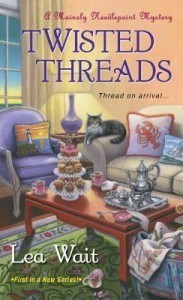 Yes — I’ve had thirteen books published, and more to come. But I’ve written four complete books and researched and written parts of another four or five, none of which have sold. I went six years without any contracts, when everything I wrote was rejected. And the publishing industry has changed. Even though I’m now publishing again, I’m working harder, writing more books in shorter time periods … and earning a great deal less money than I did in my first years as a published author.
Yes — I’ve had thirteen books published, and more to come. But I’ve written four complete books and researched and written parts of another four or five, none of which have sold. I went six years without any contracts, when everything I wrote was rejected. And the publishing industry has changed. Even though I’m now publishing again, I’m working harder, writing more books in shorter time periods … and earning a great deal less money than I did in my first years as a published author.
Writers, like most people, don’t like to talk about the hard realities of finances. But I’m a long way from “earning a living from my writing” as one librarian said to me recently. And as a writer married to a painter … I joke that we “starve in two fields.” But it isn’t totally a joke.
What did I learn during those dark days when nothing I wrote would sell?
I learned patience. I learned marketing – planning and writing books that would meet marketplace needs. I learned to live more economically.![51qkuGEqAxL._AA160_[1]](https://i.gr-assets.com/images/S/compressed.photo.goodreads.com/hostedimages/1432955724i/15028908.jpg)
And I read, and read, and studied books that were selling.
I think my writing improved. Certainly my social media and marketing skills did.
But those years were very hard.
Yes, I was lucky. I sold the first eight books I wrote. But I paid for that success. Now, I’m lucky again to be publishing.
But I don’t take sales for granted. My successes mean more because of my failures.
What else did I learn? Nobody is lucky all the time. And .. not to give up. Yes, success takes luck. But luck comes to those who work for it. I don’t know any published authors who don’t work very hard.
It’s the way the writing life is.
The Mystery Dog Comes to Camden
A month ago, my oldest son Matt texted me from St. Croix in the Virgin Islands, where he lives and works as the Captain of a 120-foot charter yacht. He was coming home for a visit on April 29th, and asked what I’m sure he thought would be a laughed off kind of question:
THERE ARE A FEW PUPPIES UP FOR ADOPTION. WANT ME TO BRING YOU ONE?
Vicki Doudera here. Of course his text was accompanied by this very sweet photo.
No surprise that I found the little spotted pup adorable. Who wouldn’t? But what was surprising (to me at least!) was my nearly immediate response.
YES!!!!!!!!!!
To which Matt then wrote:
DO YOU REALLY WANT IT?
And I said: OF COURSE BUT WILL THEY LET YOU?
At this point, Matt felt he needed to clarify things. I’M SAYING DO YOU WANT ME TO BRING YOU A DOG. And then he sent this photo, with the query, WANT HIM?
And I said, YES! SO CUTE!
To which my responsible son asked, DO YOU REALLY HAVE TIME FOR A PUPPY?
Well – that’s the heart of the matter, isn’t it? Does anyone really have “time” for a puppy? Probably not. But what hit me when he asked that question was how much I wanted time for something as wonderful and random as a puppy. So — although I was not looking for a puppy, and had not even been entertaining the idea of a second dog (Dog #1 is Hoover and you’ve met him before — a staid 10 year old Cavalier King Charles Spaniel) I found myself saying yes, out of the clear blue, to Matt’s question. Yes, I have time for a puppy. Yes, I want you to bring me this little creature.Yes, yes, yes to something dropped into my lap from the universe, a.k.a. my eldest son.
Next came a few photos of the puppy. post-adoption, courtesy of Matt and his girlfriend Sarah. Here’s the puppy chilling on one of the island’s pretty beaches…. being cuddled by Sarah…
being cuddled by Sarah…  and keeping Matt company in front of the yacht.
and keeping Matt company in front of the yacht. A few days after this photo was taken, Dempsey arrived in Maine, only five weeks old but full of energy. A visit to the vet revealed that the pup was healthy and… another surprise… a female! We’ve been loving her ever since. Do we know “what” she is? No clue. The puppies were abandoned, so her lineage is a big question mark. As is her ultimate size. Will she be small or big? Who knows? But three weeks in our home and she already knows her name and the routine. Our mystery dog is here to stay, a good reminder of why sometimes, when a question comes out of the blue, it just pays to say YES.
A few days after this photo was taken, Dempsey arrived in Maine, only five weeks old but full of energy. A visit to the vet revealed that the pup was healthy and… another surprise… a female! We’ve been loving her ever since. Do we know “what” she is? No clue. The puppies were abandoned, so her lineage is a big question mark. As is her ultimate size. Will she be small or big? Who knows? But three weeks in our home and she already knows her name and the routine. Our mystery dog is here to stay, a good reminder of why sometimes, when a question comes out of the blue, it just pays to say YES.
May 25, 2015
Just Cranking them out (for the money) . . . Not!
Kaitlyn Dunnett/Kathy Lynn Emerson here, today writing as Kathy.
 You know how that one bad review sticks with you far longer than a dozen good ones? You tell yourself it’s just one person’s opinion, even if that one person is a reviewer for a major national review journal. You try not to be hurt by what seems like a personal attack. You wonder how anyone can possibly claim to know your motivation for writing a particular book. And, somehow, you never quite get over being ticked off about what amounts to an attack on your personal integrity as well as your ability as a writer.
You know how that one bad review sticks with you far longer than a dozen good ones? You tell yourself it’s just one person’s opinion, even if that one person is a reviewer for a major national review journal. You try not to be hurt by what seems like a personal attack. You wonder how anyone can possibly claim to know your motivation for writing a particular book. And, somehow, you never quite get over being ticked off about what amounts to an attack on your personal integrity as well as your ability as a writer.
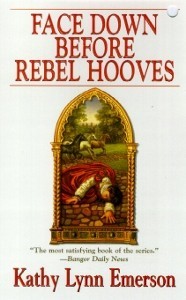 So, almost fourteen years later, I’m finally going to address the issues raised by a particularly upsetting review of one of my mystery novels. It ran on July 8, 2001 in Publishers Weekly and to add insult to injury, the anonymous reviewer didn’t even get the title right, calling it Face Down Beneath the Rebel Hooves when it is actually Face Down Before Rebel Hooves.
So, almost fourteen years later, I’m finally going to address the issues raised by a particularly upsetting review of one of my mystery novels. It ran on July 8, 2001 in Publishers Weekly and to add insult to injury, the anonymous reviewer didn’t even get the title right, calling it Face Down Beneath the Rebel Hooves when it is actually Face Down Before Rebel Hooves.
In the body of the review, this reviewer states that “what starts as clever plot-counterplot and an unmasking of conspirators ends up in such confusion that one doubts whether the author herself can unravel the tangled web of deceit.”
Uh, sorry Anonymous—I wasn’t confused at all and neither was my editor and neither were numerous other people who reviewed this mystery novel and signed their names to their reviews.
Anonymous continues: “Emerson fails to evoke either Susanna’s devotion to Elizabeth or the religious fervor that fires the conspirators.”
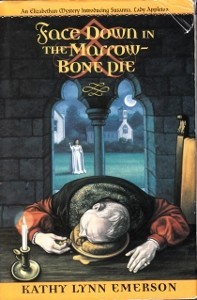 Well, that was sort of the point. Susanna is not radical in her thinking, either about politics or religion, and has never been all that fond of Queen Elizabeth. Although she’s far from being a traitor to England, she does have some sympathy for both sides of the issue and a great deal of sympathy for one of the conspirators, a woman she ultimately helps to escape to Scotland. She didn’t agree to go undercover as a spy to foil a treasonous plot so much as to unravel the more personal mystery posed by the fatal accident that befell the wife of an old and dear friend. As for the religious fervor of the conspirators, my take on the situation was that the rebellion was prompted far more by their political ambitions than by their Catholicism and this is backed up by various studies of the real rebellion upon which the novel is based.
Well, that was sort of the point. Susanna is not radical in her thinking, either about politics or religion, and has never been all that fond of Queen Elizabeth. Although she’s far from being a traitor to England, she does have some sympathy for both sides of the issue and a great deal of sympathy for one of the conspirators, a woman she ultimately helps to escape to Scotland. She didn’t agree to go undercover as a spy to foil a treasonous plot so much as to unravel the more personal mystery posed by the fatal accident that befell the wife of an old and dear friend. As for the religious fervor of the conspirators, my take on the situation was that the rebellion was prompted far more by their political ambitions than by their Catholicism and this is backed up by various studies of the real rebellion upon which the novel is based.
Anonymous saved his or her snarky best for the “Forecast” at the end of the review: “The thinness of the last two or three books of what started as a solid historical series suggests that the author has lost interest and is just churning them out.”
True, the words “for the money” aren’t there in print after “churning them out,” but they’re certainly implied.

one scene in Rebel Hooves takes place in the shadow of this ancient stone “arrow”
tall milfs cougars that crave black cocksAt that point in my career, even though there had been five previous books in the series, I wrote each book on spec, not submitting it until it was written and not receiving an advance until it was accepted for publication by St. Martin’s Minotaur line. In the case of Rebel Hooves, which was based on the Northern Rebellion of 1569, I started research and plotting in April 1999. What fascinated me about the event was the fact that the leading lights were two women, the countess of Northumberland and the countess of Westmorland. I brought my sleuth, Susanna, Lady Appleton, into the action by having her recruited to help an old friend whose wife (Rosamond’s mother) had been helping the rebels. Writing the first draft took four months, from August 19, 1999 until December 22, 1999. Between early January and the end of May of 2000, I did four further drafts before sending the book to my agent. At that point, and only at that point, was I offered an advance of $7500 against future royalties, which I accepted. Incidentally, I never received an advance higher than $8000 for any book in the series. The print run for this one was 5500 copies in hardcover. Translated, that means that even if every single copy sold, my maximum earnings would still be less than $12,000 for a project I worked on for over a year. Since sell-through is never that good, even for bestselling authors, I made back the advance plus a few hundred dollars, so even if I only count the four months that I spent writing the first draft and figure that I only spent four hours a day, seven days a week . . . well, you do the math. Add in the hours involved in research, revising, etc., etc., and I think I can guarantee that I was working for less than the minimum wage.
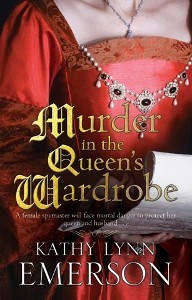 Churning them out, for the money or for some other reason? I don’t think so. And if I’d lost interest, I certainly wouldn’t have spent that much time on the project. I’d have been hunting for something else to write, preferably something that would earn me a bigger advance.
Churning them out, for the money or for some other reason? I don’t think so. And if I’d lost interest, I certainly wouldn’t have spent that much time on the project. I’d have been hunting for something else to write, preferably something that would earn me a bigger advance.
I can laugh about this now. Sort of. But obviously it took me a long time to get that criticism out of my head. I wrote one more book in this series for St. Martin’s and three more for Perseverance Press, as well as numerous short stories using the characters. I’m still writing about that world because I still haven’t lost interest. My new series, starting with Murder in the Queen’s Wardrobe, features Rosamond Jaffrey, Lady Appleton’s late unlamented husband’s illegitimate daughter by Eleanor Pendennis—the old friend’s wife being impersonated by Susanna in Face Down Before Rebel Hooves. The second book is just through line edits and has a great cover.
I’m working on number three.
Lost interest? No way!
May 24, 2015
How Stephen King (and my mom) helped me become a published writer
Hi all, Maureen Milliken here in my first official Maine Crime Writers post, though I’ve been a guest a 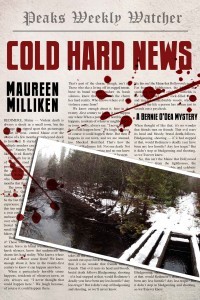 couple times.
couple times.
My entry into this excellent community of mystery writers comes a little less than two weeks before my debut mystery novel, Cold Hard News, is being released.
One question I get asked a lot is how long it took me to write the book. How long? Well, um. Hmm.
There are a lot of ways to answer that and the answers range from “my whole life” to “several years.”
I’d always wanted to write mysteries since I was around 9 or 10 years old. I read every kids’ mystery series I could get my hands on, graduating to adult books by the time I was 12 or so. I spent a lot of time in bed at night, or staring out the window in school or on long car trips reworking the characters and plots from my favorite TV shows: “The Mod Squad,” “The Rookies,” “The Streets of San Francisco,” “Columbo.” Looking back, it should have been obvious I’d become an editor, too (I am news editor of the Kennebec Journal in Augusta and the Morning Sentinel in Waterville) — I could spend hours or days reworking one scene in my head to get the dialogue or a character right.
The years went by and I never stopped thinking that “someday” I’d start writing that mystery novel, but somehow I never got around to it. Busy with jobs, relationships and work, I found a lot of excuses. But deep down, I realized what the real reason was — I didn’t know how to start. I’d convinced myself I needed to have the plot all figured out, the story all set in my head. I read a book by a mystery writer who I admired quite a bit who said she did full biographies of each character and deep outlines on each chapter before she began to write. I had some vague ideas about characters, themes and setting, but nothing else. I was paralyzed by the thought that I’d have to do all that before I could begin the book.
Another thing holding me back, which I only admitted to myself once I finally got going, was that what if I couldn’t do it? What if it sucked? What if the thing I’d always thought I would do turned out to be something I couldn’t?
About eight years ago, I’d recently started writing a newspaper column again at the paper I worked for in New Hampshire at the time and had gotten quite a response from readers. I hadn’t been a reporter or really written much of anything in more than a decade at the time, and told my mother I’d forgotten how empowering it felt to write and to have an impact on readers.
Her response? “Well, Mo, I’ve always thought of you as a writer.”
That comment had a profound effect on me. I felt like a huge fraud. How can someone who hasn’t written anything be a writer? It was time to fix that.
Que the book by the famous author who outlines everything. Then my inaugural trip to the New England Crime Bake, a mystery writer’s conference that gave me the kick I needed.
But I still couldn’t figure out how to get started.
That’s where Stephen King comes in. I bet you were wondering.
In my desperation for some kind of key to unlock the secret formula, I picked up his book “On Writing.” Half autobiography, half writing kick-in-the-pants, it was just what I needed. There’s a lot of good stuff in that book, but the biggest takeaway was to stop talking about writing and just sit down and do it.
And he was right. I had an opening for the book, a plot explosion I knew was going to happen that was going to upend everything, characters I’d been developing in my head for 30 or more years, and some themes I wanted to be sure got in there, particularly loyalty and the price of friendship. I also knew it would take place in Maine (even though I was living in New Hampshire at the time) and that it would have a heavy and realistic newspaper theme. I wasn’t sure how it would all come together in a book, but after reading “On Writing” I felt a physical compulsion to start getting it down on paper.
I got over the fear and inner resistance and started writing. And Stephen King, brilliant as he is, was right. Things started happening, almost beyond my control. Characters did things, the plot started making itself known. It wasn’t easy, but knowing that it was working the way it was supposed to and the fun I was having doing it kept me going.
And now here we are, several years later, welcoming “Cold Hard News” to the world.
Another thing people have frequently said to me upon finding out my first mystery novel is about to be published: “Gee, I wish I could write a book.”
Well? OK. Start writing.
Cold Hard News will be released June 6 by S&H Publishing. Print and ebooks can be preordered at S&H Publishing, and ebooks can also be preordered on Amazon Kindle and Smashwords.
Check out my website, maureenmilliken.com, follow me on twitter at @mmilliken47 and look for updates on my Facebook page, Maureen Milliken mysteries.
May 22, 2015
Weekend Update: May 23-24, 2015
 Next week at Maine Crime Writers there will be posts by Maureen Milliken (Monday), Kaitlyn Dunnett/Kathy Lynn Emerson (Tuesday), Vicki Doudera (Wednesday), Lea Wait (Thursday) and Barbara Ross (Friday).
Next week at Maine Crime Writers there will be posts by Maureen Milliken (Monday), Kaitlyn Dunnett/Kathy Lynn Emerson (Tuesday), Vicki Doudera (Wednesday), Lea Wait (Thursday) and Barbara Ross (Friday).
In the news department, here’s what’s happening with some of us who blog regularly at Maine Crime Writers:
This coming Thursday, May 28th, the Maine Literary Awards will be presented at the Space Gallery in Portland. Doors open at 6:00 p.m. and the ceremony starts at 7. MCW will be represented by Vaughn Hardacker and Kate Flora and alum Paul Doiron. This is a fun event celebrating the talents of Maine writers.
John Clark‘s retirement party will be held from 1-3 p.m. on Saturday, May 30th at the Hartland Library. Sweets and snacks and a sad farewell and a chance to meet the incoming librarian.
Brenda Buchanan is kicking off a little library tour to talk about her debut mystery, Quick Pivot, with a stop at Baxter Memorial Library in Gorham at 6:30 on Wednesday, May 27, and a noontime chat at Portland Public Library on Friday, May 29. Last week she launched Quick Pivot, with a convivial party at RiRa, an Irish pub on the Portland waterfront. Here’s a photo of Brenda with some of the other Maine Crime Writers who came to raise a pint to the success of her book.
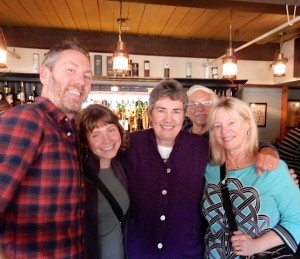
Chris Holm, Katrina Niidas Holm, Brenda Buchanan, Ken Cohen and Kate Flora at Ri Ra
tall milfs cougars that crave black cocks
Last week, Kate Flora threatened you with a rhubarb…a rhubarb recipe, that is. So here, for those of  you who have a rhubarb patch and can’t wait for a sweet version of this venerable spring tonic, is:
you who have a rhubarb patch and can’t wait for a sweet version of this venerable spring tonic, is:
Rhubarb Strawberry Pudding Cake (heat over to 400 and butter 8″ square baking dish)
1/4 c. water, 1 1/2 t. cornstarch, 1/3 c. sugar. Stir together in saucepan and add 2 c. chopped rhubarb.
Bring to a boil*, stirring constantly, then simmer, stirring occasionally, for 3 minutes. Remove from heat and add 1 c. chopped strawberries.
Whisk together 1 c. flour, 1 3/4 t. baking powder, 1/2 t. salt, and 1/2 c. sugar in a bowl.
In large bowl, whisk together 1 large egg, 1/2 c. milk, 1 stick unsalted butter, melted and cooled slightly, and 1 t. vanilla. Then whisk in flour mixture.
Reserve 1/2 c. fruit mixture. Pour the rest into baking dish and pour batter over it. Drizzle remaining fruit over batter. Bake 25-30 minutes, or until toothpick comes out clean. Cool 5 minutes before serving.
From Gourmet, April 2007
*original recipe says bring to simmer. Kate says bring to boil, then simmer. Your choice.
And some sources say that rhubarb was first introduced to the new world by someone from Maine. http://www.rhubarbinfo.com/history
From Kaitlyn Dunnett/Kathy Lynn Emerson: For those who remember my blog on the town of Wilton needing to establish itself as a “slum and blight” in order to qualify for grant money (see http://mainecrimewriters.com/?s=slum+and+blight), there is good news. It worked. For the whole story in our local online newspaper, you can click here Daily Bulldog
An invitation to readers of this blog: Do you have news relating to Maine, Crime, or Writing? We’d love to hear from you. Just comment below to share.
And a reminder: If your library, school, or organization is looking for a speaker, we are often available to talk about the writing process, research, where we get our ideas, and other mysteries of the business. Contact Kate Flora: mailto: kateflora@gmail.com
Meet the New Hartland Librarian-Nicholas Berry
John Clark introducing everyone to my successor as librarian in Hartland. Right after we finished interviewing Nick, Karen McGrady who is a trustee and headed the search for a new librarian, looked at me and asked, “What do you think?” “It was like talking to a younger version of myself,” I replied. She nodded in agreement. What are the odds you’ll find someone who not only reads, but writes in the YA fantasy genre to pick up where you left off? Well, that’s what we did and I’m excited to have Nick step in and take the library to new places.
He’s a native mainer and has his undergraduate degree from UM-Farmington and his MLIS from Syracuse University. You can’t ask for better credentials than those when looking for someone to run a small, but extremely bust public library. While I plan to stay involved as a volunteer, I’m being extremely careful to act as a resource and let Nick have the freedom to do what he sees fit in order to run the library. If you’re interested, we’re having an open house at the library to celebrate the changing of the guard as well as recognize our valued volunteers. This takes place on Saturday, May 30th from 1-3 at the library which is located at 16 Mill St. in Hartland. Anyone reading this is welcome.
Here’s an interview I did with Nick for the blog.

Nick in the chair he’ll soon be using on a daily basis.
tall milfs cougars that crave black cocksWhat was your life like growing up–where, interesting things you did, what did you read, what were your hobbies
I grew up in Livermore, Maine. I mostly spent my time reading (a lot of boxcar children mysteries and great illustrated classics among other things, later Dragonlance and Terry Pretchett novels), swimming, camping, and hiking, mostly with the cub scouts and boy scouts. I also developed a love for board games and table top games in general. I also was involved with area youth sports or AYS that was organized between Livermore, Livermore Falls, and Jay. Soccer and baseball, and a couple years of basketball. I was never really athletic but it got me involved, and I was on a soccer team through freshman year of high school before it got more about competing than playing the game. I also spent a lot of winters skiing, not coming in until I was soaked through and frozen. I also played the trumpet from fourth grade through freshman year of high school in school band. Actually found myself reminiscing and wanting to relearn when I pulled it out of the closet this weekend. Other than that I have always been an animal lover, mostly dogs but at one time my family had two dogs and two horses (one of which was friendly most of the time but would only let my mom ride her). I actually got thrown off one of them and hit my head on a rock once (thankfully was wearing a riding helmet). Other than that it was a lot of family gatherings, writing, and going to the library.
How did you survive high school? What was the best part of it, worst part?
I mostly survived high school by putting my nose to the grind stone and focusing on school, always a bit of a complete nerd. I think the worst part was the little bit of bullying I encountered but I just tried to move on to different people. I think the best part was the trip I took to England through the school. Best decision I made to get some experience visiting other countries. Lots of history, lots of walking, and some nasty swans.
You went to UMF what was your college experience like? Highlights, defining moment(s)
Well, at first I was an English major, but as soon as I got there I realized I really wanted to be a writing major, so the first year was started with me learning what classes both majors required and taking those in addition to general electives. I spent the first two years applying to the creative writing program and taking advice from writing professors, including the director of the program. I felt a profound sense of accomplishment when I was finally accepted to the program.
My freshman year I had a group of friends, we went to all the meals together, went to the movies together, but then we were split apart when two of us who were dating split up in a nasty way, and then broke further apart a year later. I reunited with one of the original group though when I became a Community Assistant, probably the best of the group to be friends with too.
After that I met two people that would become my best friends at UMF that have continued after, Sean and Erich. Sean worked in the University snack bar and would give me extra stuff, including double sized quesadillas (paid for of course). We would all get together in the snack bar on weekends when he was working and there were fewer people there, building bigger and more unhealthy quesadillas we would share, culminating in the Alpha-dilla which was multi-layered and included such things as curly fries and mozzarella sticks and anything the snack bar had in it. We each had special handshakes and would talk about what we would do if we ever got rich. We invented a place called Manada, because it would be in between Maine and Canada, where we would all live and have roller coasters connecting all of our houses, and each with a different position within this new country.
And some of my best friends were my neighbors in the residence halls and my fellow writers, many of which overlapped. Lots of weekends spent gaming, writing, and “stealing” the neighbors rug to put in front of our door until they took it back.
I think some of my best experiences were as a Community Assistant (what others may know better as an RA). I met some of the best people working that job and apart from being paid I got to create programs for people which leads into library programming too. I think my favorite programs were the writing contest I started that continued for a couple years after I left, and games of Human Clue and Human Candyland I helped plan with many other Community Assistants across campus (brainchild of my friend Cassie) which brought together CAs, residents, our Assistant Directors, Director, and Professors.
I don’t really know what got me started. I always had an active imagination, pretending I was part of my favorite shows or books, at some point I just started writing my thoughts down. I started writing poems, which led to writing a christmas poem for my family every year which I still do even though I started hating writing poetry. I then began writing short stories and starts to novels that never really got finished but was very encouraged by one of my English teachers, Mrs. Hatfield.
You majored in creative writing, did you have any professors who were memorable? Why?
The most memorable professor for me was Elizabeth Cooke. She was the professor for my first creative writing class and was my greatest support and help getting accepted to the creative writing program. Afterwards she became my academic adviser. She was always kind but constructive with her criticism and loved reading all the stories she read and was always making us think about why we wrote something a certain way. She could help turn a three page draft written in sleep deprived delirium into a great ten page story.
What got you interested in library science?
Well, I have been going to libraries since before I could read. I volunteered at my local public library in high school, and worked as a library aide in the high school library. Interesting it didn’t occur to me that I was heading towards being a librarian until I did my apprenticeship for the creative writing program at the same library I volunteered at in high school. Myra threw everything at me to see if I would crack and I just got more interested in being a librarian.
How was the Syracuse program?
The Syracuse program was great. The program focuses a lot on theory about planning, marketing and assessment but there is lots of opportunity to get hands on library experience and learning. There is a lot of room to design your own program and direction with electives once you get through the required classes. There is a strong emphasis on community and the library being the center of that community. There is also a lot of emphasis on technology and the advancement of technology in and through libraries. There are some professors that were proponents of going fully technological (libraries with no physical materials, just digital with computers and tablets to serve the patrons) but I am a proponent of middle ground. Always good to improve technology and there might become fewer books and other physical materials but there will always be a balance of digital and analog or else you aren’t really serving your community. I think the best part of the program is a lot of the courses require you to talk face to face with librarians and immerse ourselves in the profession while still learning, including with the required internship. I learned a lot with my internship with the Syracuse branches of the Onondaga Public Library System and was exposed to a lot of diversity that my education was previously lacking.

Treat Memorial Library in Livermore Falls where Nick worked before taking the job in Hartland
You started a creative writing group got young adults, tell us about that.
I always was interested in starting a writing group in a library, but obviously not if there wasn’t an interest or a need. There was also a lack of programming for teens at the library, so in the interest of improving teen services I sent out a teen survey to the local middle school and high school. When the surveys came back there was some interest in a teen writing group. It took awhile to get the advertisement out but after enlisting the help of family members in the schools we got some interest. We have six regulars, most are interested in writing fiction but there are some that want to write nonfiction or are at least interested in it. Most of the meetings have been writing prompts that I think of beforehand. I try to get a good range that allows them to write whatever kind of writing they want to, sometimes with a loose “theme.” The intent was to get them sharing their work and workshopping their pieces to improve their writing.
What/who are your influences as a writer?
I think my major influences are Terry Pratchett (mostly his humor and his version of Death), and Margaret Weis of Dragonlance fame (I share my birthday with her too so that is cool). My poetry was very influenced by Emily Dickinson. I think most of my realistic fiction has been heavily influenced by my observations of the people around me, and the aforementioned Elizabeth Cooke. Probably a bit of J.K. Rowling thrown in there as well.
You’re about to take on responsibility for a small, but active public library. Why did you apply and what are you looking forward to the most?
I grew up in rural Maine so I have always had a love for small, local libraries. The big libraries are fun too but leave a lot of corners to hide in and you don’t get to experience everything, sometimes not even getting to work hand-in-hand with the community. In libraries like Hartland Public Library you get to immerse yourself in everything and you get to meet everyone in the community and get to offer your help in helping them find what they need and want.
Where do you see yourself in ten years as a librarian, as a writer?
I don’t know where I see myself in ten years with either, I’m really open to anything as long as I am part of this world of libraries and writing. Hopefully I will have been published and hopefully I am still learning from my experiences as a librarian and from the patrons I am serving. Probably sounds a bit lame.
What’s the most memorable experience you’ve ever had?
Well, its not really one moment, more of an annual moment. Every year after Thanksgiving my brother, a couple of my cousins, myself and now my sister-in-law get together for a weekend of tabletop role playing games like Dungeons and Dragons or Pathfinder, and other tabletop games. We play late into the night and wake up early and eat things that are generally bad for us. Its a weekend of inside jokes, gaming and fun. We have more weekends like that but after Thanksgiving has always been constant (though sometimes with absences if someone has other things to do).
What place do you want to visit the most?
I think it would be fun to travel anywhere but being honest I think the place I most want to visit right now is the Wizarding World of Harry Potter. As I said, complete nerd. I am a huge Harry Potter fan and would love to see it if only just once.
May 20, 2015
Never Too Many Books
 Dorothy Cannell: Had a wonderful time at Malice meeting up with writer and reader friends. Also spending blissful time in the bookroom splurging on new and out of print titles. Afterwards my husband Julian and I drove Margaret Maron and her husband Joe back to Raleigh and spent a few days with them. Again more purchases there at a fabulous (huge) used book store. Great selection of mysteries from decades past, which I enjoy but also find helpful in writing my current series set in the nineteen-thirties. It being important to me to get the language right – not inserting words or phrases inapproriate to era.
Dorothy Cannell: Had a wonderful time at Malice meeting up with writer and reader friends. Also spending blissful time in the bookroom splurging on new and out of print titles. Afterwards my husband Julian and I drove Margaret Maron and her husband Joe back to Raleigh and spent a few days with them. Again more purchases there at a fabulous (huge) used book store. Great selection of mysteries from decades past, which I enjoy but also find helpful in writing my current series set in the nineteen-thirties. It being important to me to get the language right – not inserting words or phrases inapproriate to era.
I do appreciate being able to order desired books from Amazon, but there is always the delight of the treasure hunt in searching through shelves and spotting a favorite author. One who may not be much read these days but whose work, in my opinion, still holds up today. We have a great ‘Second Time Around’ store on Route 1 in Belfast. The owner is wonderfully knowledgeable about out-of-prints. She put me on to Leslie Ford, Helen Reilly, and Rae Foley. We once had a passionate discussion on Patricia Wentworth, our enthusiasm for her Miss Silver, and the pity that these mysteries do not seem to have received their deserved acclaim.
My own meanderings introduced me to Sara Woods whose protagonist Antony Maitland is a London barrister who goes above and beyond for his clients. Another find was Anthony Gilbert (pseudonym for female author) also featuring a barrister, but of the less polished short. Particular favorite is E.X. Ferrars who wrote many stand-alones, several featuring retired botany Professor Andrew Basnett.
At Malice I had a happy chat with Jim Huang, who in addition to doing some reprints of authors (including Pat Carlson), has edited or otherwise worked on a number of resource books for mystery enthusiasts under the imprint The Crum Creek Press, which I find invaluable in my searches for appealing authors past and present. These include: They Died In Vain. Overlooked, and Underappreciated and Forgotten Mystery Novels. I find these useful not only for the info, but also in being able to check off which books I have read so as to avoid repeat purchases. Needless to say I have been blissfully binge reading these past couple of weeks. Wishing you the same!
Dorothy
P.S. On a braggy note I received gratifying reviews on Death at Dovecote Hatch from Booklist, Kirkus and Publishers Weekly.
Lea Wait's Blog
- Lea Wait's profile
- 509 followers


